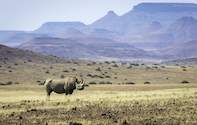
Soaring low over the rugged, brawny Etendeka mountainscape from Windhoek to the airfield at Doro Nawas, it looks like some supernatural force has diced it up with a machete. It is sobering to see the tiny farming outposts connected by sandy ant tracks and to think that people are living down there.
As the Wilderness Air Cessna Caravan approaches the little airstrip deep in the Palmwag wildlife concession that serves Desert Rhino Camp it looks like the ground has, at some time in the geological past, exploded and strewn the entire landscape with rock shrapnel. Which is in fact pretty much what has happened — not once but a few times.
That supernatural force is the earth's own thermic engine, the molten minerals that lie beneath our seemingly solid crust. The process is called plate tectonics and at least seven times over the past four billion years the planet's landmasses have been crushed together only to be torn apart again.
The last time this happened was around 130 million years ago when Gondwana was broken up to form most of today's southern landmasses as well as India (the Himalayas being one current manifestation of the process). As the southern Atlantic Ocean opened to fill the gap between Africa and South America, vast sheets of magma poured to the surface.
The volcanic Etendeka Plateau of Namibia perfectly matches the Parana landscape of eastern Brazil, but there it is covered in dense, lush vegetation and so not so easy to recognise. But it is the desert animals you have come here to see — the mountain zebras, the springbok and oryx, and also, incredibly, the small herds of elephants and even the skittish, reticent desert-adapted lions. What you did not anticipate was that the landscape itself would be such a big feature of your Damaraland adventure.
Primarily you will be looking for that most unlikely survivor, the desert-adapted black or hook-lipped rhinoceros (Diceros bicornis bicornis) that, as a species, is just hanging on to survival. It is somewhat ironic, therefore, that it is here, at the very edge of their environmental tolerance, that they have the best protection and the best chance of survival in the current frenzy of the wholesale slaughter of Africa's rhino and elephant populations.
And it is on the Palmwag Concession in Damaraland that you have a good chance of seeing the desert-adapted black rhino, even if, in years to come, your children might not be so lucky. Still, it is hard to imagine they can survive out here at all. Black rhinos are browsers and nip off the branch ends of hardy shepherd's trees, stunted mopane trees and Salvadora bushes; the telltale sign of their presence being the angled snipped off branch ends.
However, in the very dry years, when it seems nothing grows and nothing could possibly live out on the gravel plains and in the brutal hills, the rhinos subsist by eating the growing tips of the succulent, long-fingered milkweed (Euphorbia damarana). The milky latex is deadly to most animals, but rhinos and a few antelope species including kudu and klipspringers are able to digest the sticky, alkaloid juice.

 Desert Rhino Camp offers one of the most exciting Namibia safaris in rugged northern Damaraland. Partnership with Save the Rhino Trust - R...
Desert Rhino Camp offers one of the most exciting Namibia safaris in rugged northern Damaraland. Partnership with Save the Rhino Trust - R...